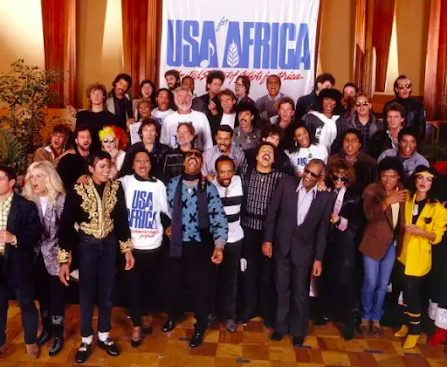Ethiopia's Famine: Drought or Political Blockade?
In 1984, Ethiopia grasped the world's attention. Videos of starving Ethiopians filled western TV screens; mothers too malnourished to produce breastmilk, children with swollen bellies circled by flies, and bleak refugee camps filled with people too famished to walk. These images, which were soon synonymised with Ethiopia and the African continent, shocked people across the globe.
Horrified by what he saw on his visit to Ethiopia, Bob Geldof brought together UK and Irish artists to compose the iconic song 'Do They Know it's Christmas?' and later organised the Live Aid concert to raise money for the victims of Ethiopia's famine. Similarly,Michael Jackson and Lionel Richie put together 'We are the World' with other US-based artists for the same cause.
 |
| 1985: USA for Africa (above) after recording 'We are the World' and Live Aid's performance in London (below) |
While the message of 'Do they know it's Christmas?' was ironic to Ethiopians, some of the world's oldest Christians, it was well-intentioned and had monumental impact. Live Aid raised global media attentions to the atrocities of the Ethiopian famine and raised $127 million for relief, pressurising the Ethiopian government that the world was watching.
However, what western audiences were unaware of was that this famine was largely man-made. In his seminal 1981 work 'Poverty and Famines', Amartya Sen referring to the 1974 Bangladesh famine, reached the conclusion that famines can occur as a consequence of entitlement (access) failure, rather than a decline in the aggregate availability of food. Sen applied the same analysis to explain the 1974 and 1984 famines in Ethiopia. While the famine was blamed on drought and failed rains by the Ethiopian government, the underlying political causes were ignored.
Drought as an Excuse for Famine
During the 1970s and 80s, Ethiopia was ruled ruthlessly by the Derg regime, a military junta led by Mengistu Haile Mariam. In the early 1980s, fearing the insurgency of opposition groups in northern Ethiopia (particularly in the Tigray region), the Derg sent federal troops to the region and bombarded cities and villages. In addition, the Derg regime used food as a military strategy against the people of Tigray, using drought and failed rains as a pretext for people's starvation.
Ethiopia as a country has a very small external water footprint, meaning the majority of its freshwater use is from freshwater resources within the country -from precipitation, to groundwater, to rivers. Yet the north of Ethiopia has a semi-arid climate, with high spatial and temporal rainfall variability, putting northern regions at risk of recurrent drought and land degradation by water erosion.
Between 1980-1984, severe and unusual droughts were claimed in the Tigray region, ultimately resulting in the 1984 famine that took the lives of 2 million people. Yet in a report for Human Rights Watch, Alex de Waal argues that between 1980-1983, the droughts were "unremarkable" for the region. It was only 1984 that marked a drought year of abnormal severity due to exceptionally low rainfall. De Waal and other critics argue that despite the 1984 drought, the famine could have been averted: "Famine, on the other hand, which is among other factors related with drought, is entirely human made." The reasons behind Tigray's famine can thus be explained, not by drought or water scarcity, but by the politics of the day and the tensions that ensued. Further explanations are outlined below:
1) The military/intentional destruction of food sources.
In the Tigray and northern Amhara region (Wello), the vast majority of the population rely on rain-fed, labor-intensive agriculture for their livelihoods. Families store grains as a reserve for when crop yields are low due to insufficient rainfall. Yet the Derg regime, as part of its war tactic, burned crops in fields and destroyed grain stores across the region, eliminating people's subsistence. This tactic was used to quash northern resistance against the Derg's political hegemony.
2) Denied help with food shortages.
Food shortage resulting from poor rains and harvest failure is not unusual in northern Ethiopia. In fact, humanitarian agencies are usually in the vicinity and prepared for times when help is needed. In 1984 however, the region was blockaded from humanitarian aid by the Derg regime, which meant there was no aid or support to supplement food shortfalls as would be under normal circumstances. Left with no alternative, thousands walked to Sudan for sanctuary.
3) National food surplus, but unequal food distribution across Ethiopia and restriction of movement.
In 1982 and 1983, Ethiopia had two of the best years for crop production on record. While there may have been food shortages in certain regions, the simplistic explanation of famine as a prolonged drought-driven food shortage is difficult to substantiate. Some studies in Tigray even suggest that there was food surplus despite the drought: "A survey done among Tigrayan refugees in Sudan in 1985 found that their highest yields in the last ten years occurred in 1982-83." Additionally, as the Derg regime restricted movement of people across Ethiopia, people were prevented from migrating in search of food as they usually did when food supplies were limited.
As indicated earlier, 1984 marked a year of low rainfall. However, low rainfall patterns in a single year, while it contributes to food insecurity, should not lead to famine outcomes such as that of 1984/5. The combination of military violence, blockade of humanitarian aid and restriction of people's movement created the conditions for this man-made tragedy to unfold. Drought was simply a convenient way to frame the famine in a way that was palatable to people who did not understand the complex politics of the Horn of Africa. In my next blog, I will continue to focus on the intertwined natures of drought, famine and politics in northern Ethiopia, exploring how changes in water policy in the 1990s alleviated the human impacts of low precipitation, and the situation with clean water access today.




Comments
Post a Comment